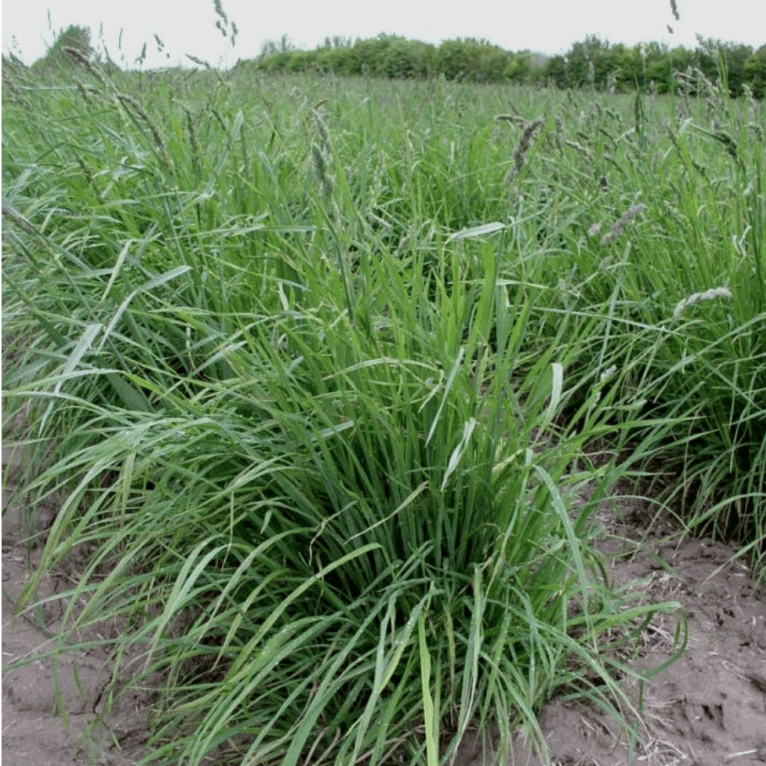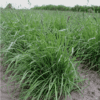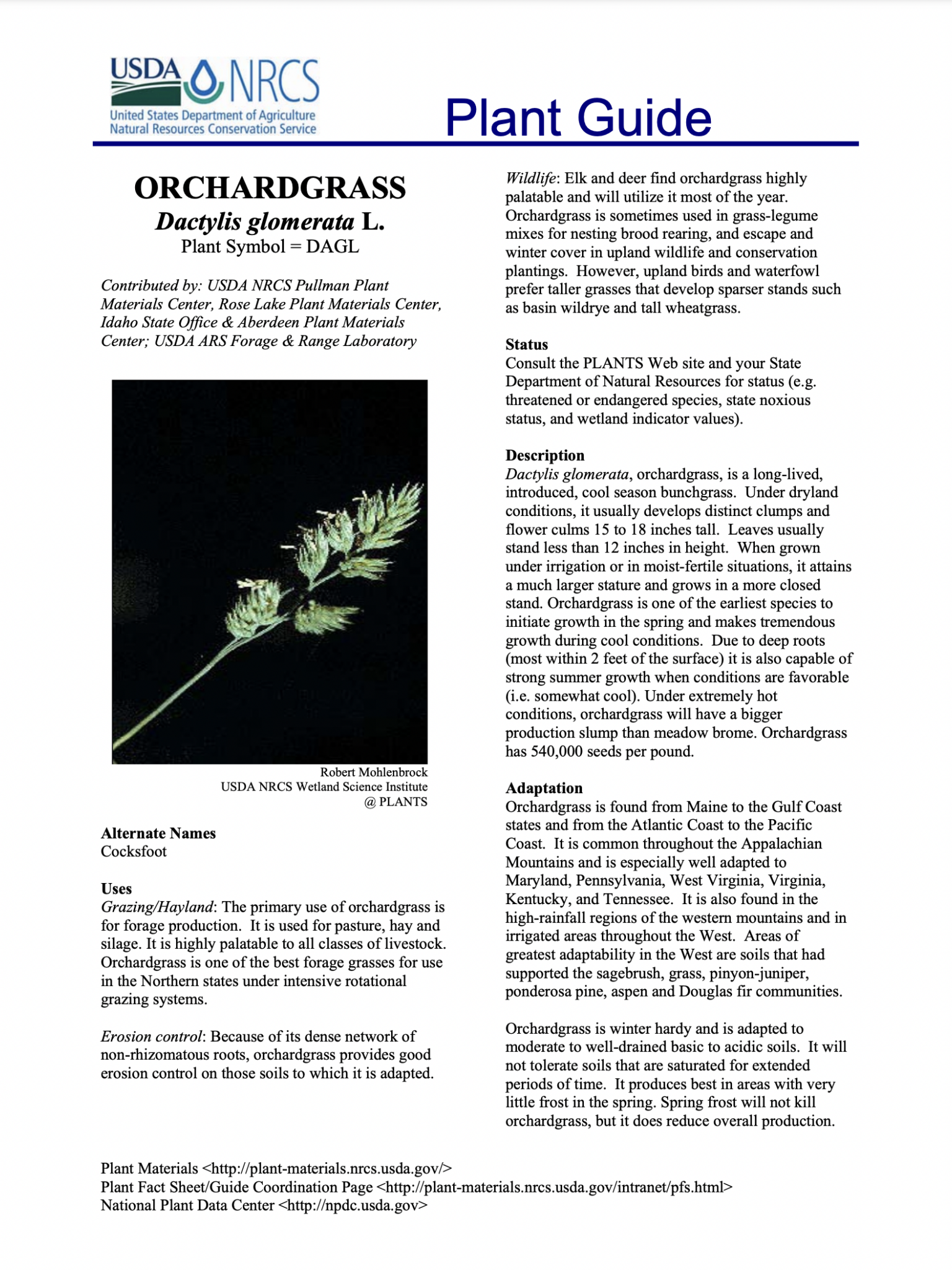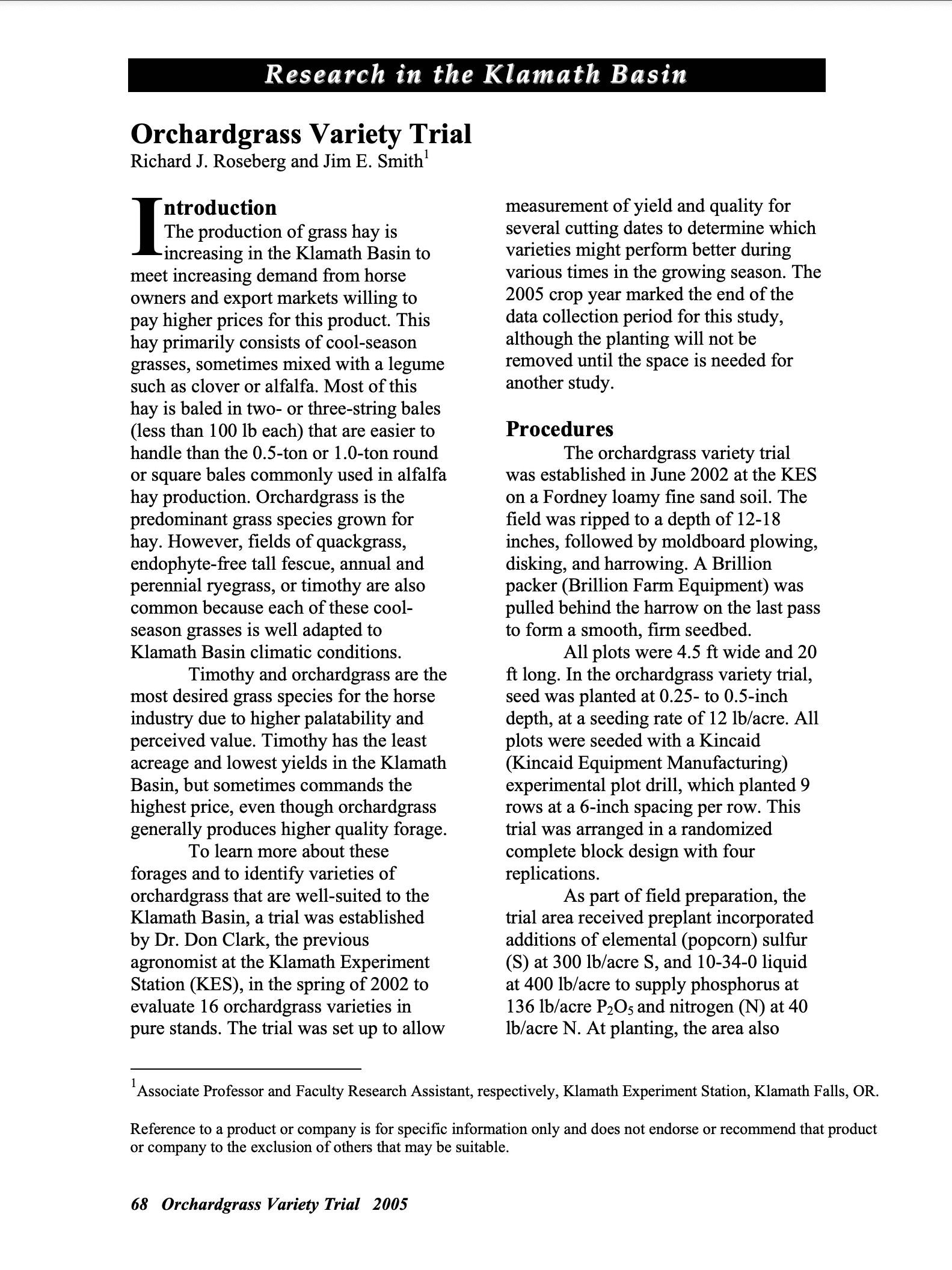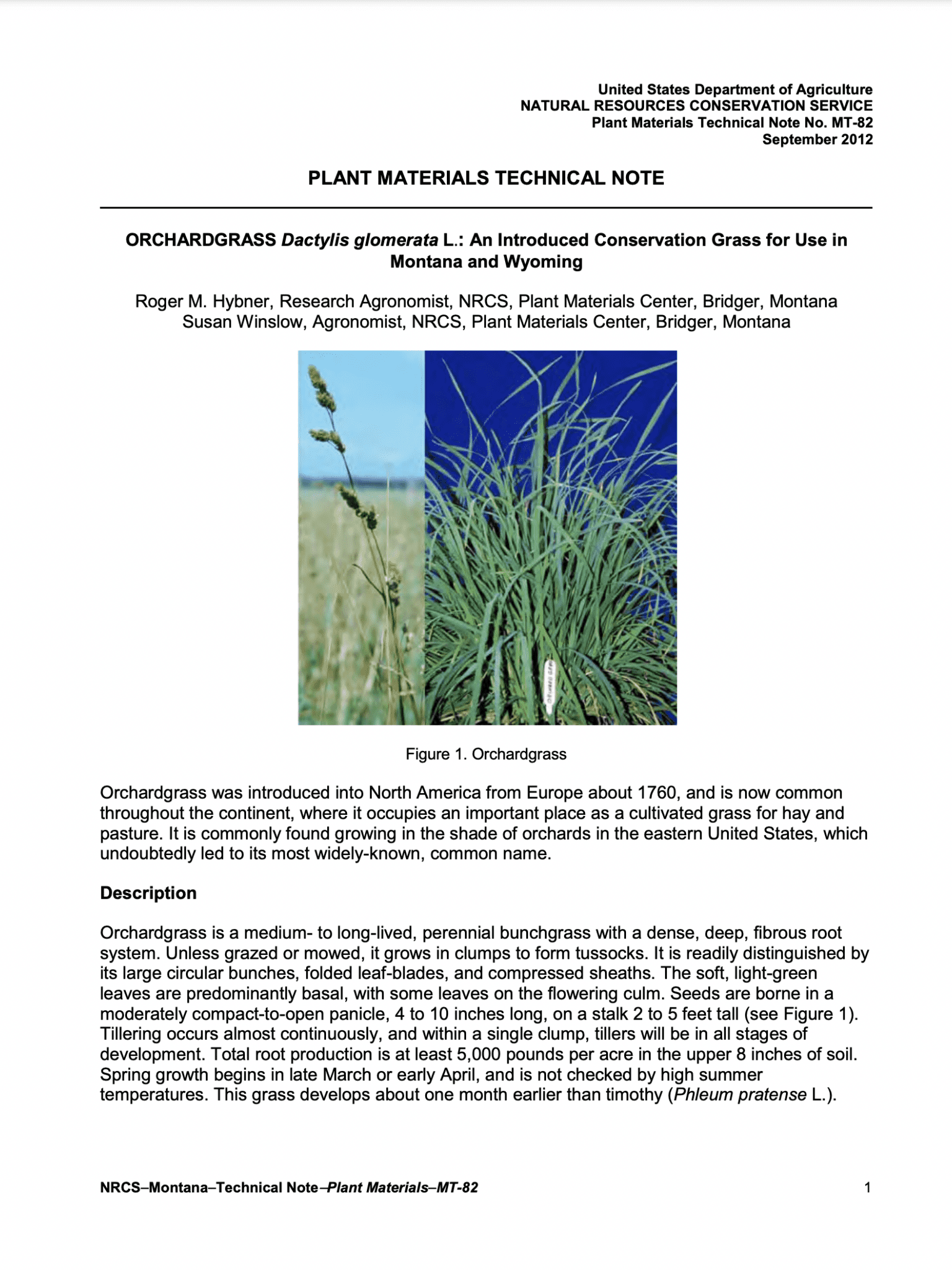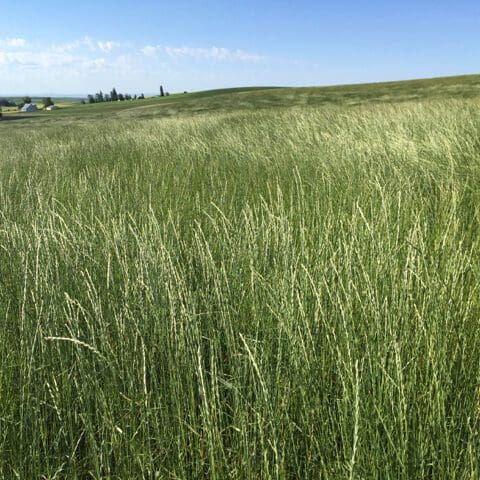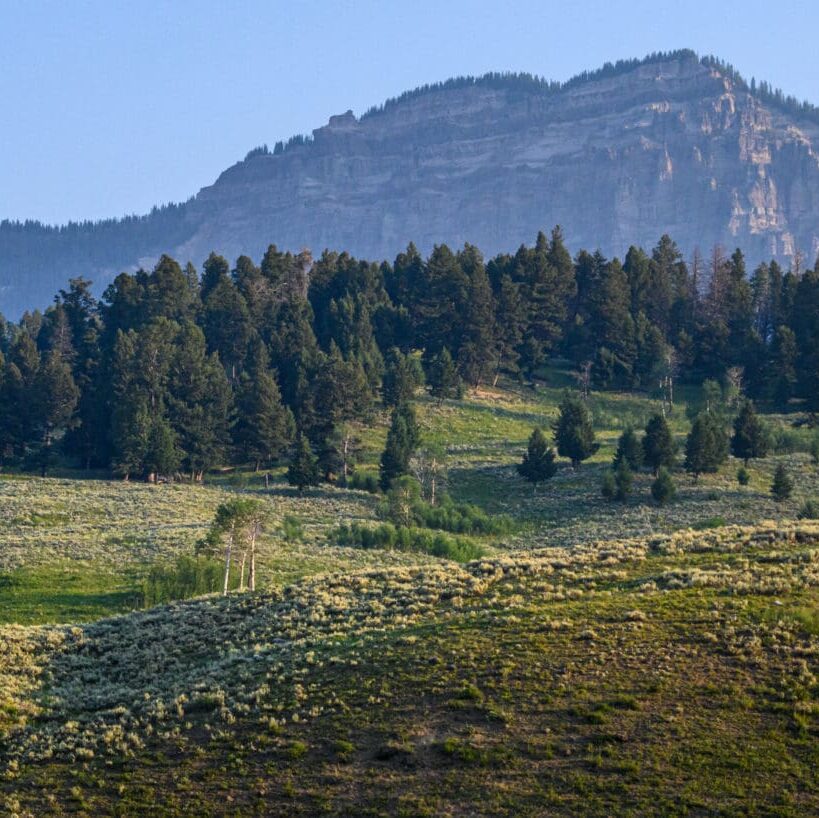Potomac Orchardgrass (Dactilis glomerata) is a productive, persistent, rust-resistant cultivar that produces good yields but matures too early to be compatible with alfalfa for hay. When alfalfa is ready to cut, ‘Potomac’ is too mature to produce good quality hay. Potomac Orchard Grass is a bunch-type, tall-growing, cool-season perennial grass. It is one of the most productive cool-season grasses, tolerant to shade, fairly drought resistant with moderate winter hardiness. Potomac Orchardgrass (Dactilis glomerata) does not exhibit as much tolerance to drought or winter hardiness as tall fescue and bromegrass. It has been reported growing in the United States since before 1760.
Wildlife: Elk and deer find orchardgrass highly palatable and will utilize it most of the year. Orchardgrass is sometimes used in grass-legume mixes for nesting, brood rearing, escape, and winter cover in upland wildlife and conservation plantings. However, upland birds and waterfowl often prefer taller grasses that develop sparser stands such as basin wildrye and tall wheatgrass. In areas disturbed by fire where orchardgrass has been seeded in a mixture with other grasses and forbs, wildlife use increases. The caterpillars of the Many- Lined Wainscot moth (Leucania multilinea) and the Little Wood Satyr butterfly (Megisto cymela) feed on the foliage of the grass and seeds are eaten sparingly by some songbirds including the horned lark and chipping sparrow.
Manure and biosolids application: Orchardgrass can use high rates of Nitrogen (N) when grown on deep soils with adequate water supplies, making it valuable in nutrient recycling systems. It can be used in manure and biosolid applications to recycle large amounts of N (in excess of 300 pounds N/ac/yr) while simultaneously producing high quality forage.
When seeded in a monoculture, Potomac Orchardgrass often produces very high yields. This variety should be used where early maturity is needed and as a single species hay. This plant may become weedy or invasive in some regions or habitats and may displace desirable vegetation if not properly managed
The primary use of orchardgrass is for pasture and hay forage production. It is highly palatable to all classes of livestock. It is one of the best forage grasses for use in the Northern states under intensive rotational grazing systems. It is compatible with many legumes (alfalfa, birdsfoot trefoil, and various clovers) and with some grasses such as perennial ryegrass and tall fescue (Sullivan, 1992). The life cycles of orchardgrass and alfalfa match well.
Scientific name: Dactylis glomerata
***Click on the “Quick Plant Facts” tab above for more information.
Other Orchardgrass Cultivars:
| Variety | Maturity | Notes: |
|---|---|---|
| Paiute | Early | Drought tolerant. Common in dryland pastures, reclamation, erosion control. |
| Hallmark | Early | High Yielding |
| Benchmark Plus | Early | Persists under heavy use, superior forage. Superior for grazing. |
| Potomac | Early-Mid | Excellent early variety. |
| Quickdraw | Early-Mid | Fast recover after cutting. Tolerates heat. |
| Pawnee Orchardgrass | Mid | Widely adapted, drought and grazing tolerant. |
| Crown Royal | Mid-Late | Fast recovery after cutting, tolerates heat. |
| Extend | Mid-Late | Ideal for alfalfa & clover mixes. Superior yield. |
| Blizzard | Late | Superior winter survival. Widely adapted, excellent forage yield. |
| Sunset Orchardgrass | Late | Excellent for use with hay, clover or pasture mixes. Improved foliar disease resistance. |
| Sundown Orchardgrass | Late | Aggressive tillering and fast re-growth. Maturity is similar to that of Pennlate. |
| Latar | Late | Old variety with limited availability. Extend, Quickdraw, Sunset and Sundown are improved varieties. |
Orchardgrass NRCS Plant Guide and Fact Sheet
Orchardgrass NRCS Plant Guide and Fact Sheet
PDF version of NRCS Plant Guide & Fact Sheet
Prepared By: Tony Bush USDA NRCS Rose Lake PMC East Lansing, Michigan
Dan Ogle USDA NRCS Idaho State Office Boise, Idaho
Loren St. John USDA NRCS Aberdeen PMC Aberdeen, Idaho
Mark Stannard USDA NRCS Pullman PMC Pullman, Washington
Dr. Kevin B. Jensen USDA ARS Forage and Range Research Laboratory, Utah State University, Logan, Utah
Species Coordinator: Mark Stannard USDA NRCS Pullman Plant Materials Center
Pullman, Washington
Orchardgrass Variety Trial 2005
Orchardgrass Variety Trial 2005
Research in the Klamath Basin
Prepared By: Richard J. Roseberg and Jim E. Smith
Orchardgrass Hay Production Guide for the Columbia Basin of Washington
Orchardgrass Hay Production Guide for the Columbia Basin of Washington
Prepared By: John L Kugler, WSU Grant/Adams County Extension
Orchardgrass NRCS Plant Materials Technical Note
Orchardgrass NRCS Plant Materials Technical Note
An introduced Conservation Grass for Use in Montana and Wyoming
Prepared By: Roger M. Hybner, Research Agronomist, NRCS, Plant Materials Center, Bridger, Montana
Susan Winslow, Agronomist, NRCS, Plant Materials Center, Bridger, Montana
Helpful Links
Additional information about this product can be found on the academic websites linked below.
Synonyms
Many plants have more than one common and scientific name. We've listed a few of them below.
- Potomac Orchardgrass
- Dactylis glomerata
Who is Great Basin Seed?
Great Basin Seed is a seed company that specializes in seed sales and consultation for home, ranch, farm, range and reclamation. We have been a leader in the seed industry since 1974.
Our History
We've been in the seed business since 1974.
What We Offer
We offer seed for home, farm, ranch, range and reclamation projects.
Meet the Gang
We have the best employees in the world! We are proud of the work they do, and trust them to serve you!
Right: Company founder Lloyd and his wife Paula Stevens in a wildflower seed production field circa 1977
Quick Plant Facts
| Common Name: | Potomac Orchardgrass |
|---|---|
| Scientific Name: | |
| Lifespan: | |
| Plant Type: | |
| pH Tolerance: | |
| Seed Count | 540,000 |
| Root Form | Sodformer |
| Sowing Rate | 2-4 PLS lbs. per Acre |
| Min. Precipitation | 16 Inches Minimum |
| Best Sowing Time | Fall or Spring |
| Max Sowing Depth: | |
| Growth Season: | |
| Sun & Shade Tolerance: | Part Shade |
| Elevation of Occurance: | |
| Hardiness Zones: |
